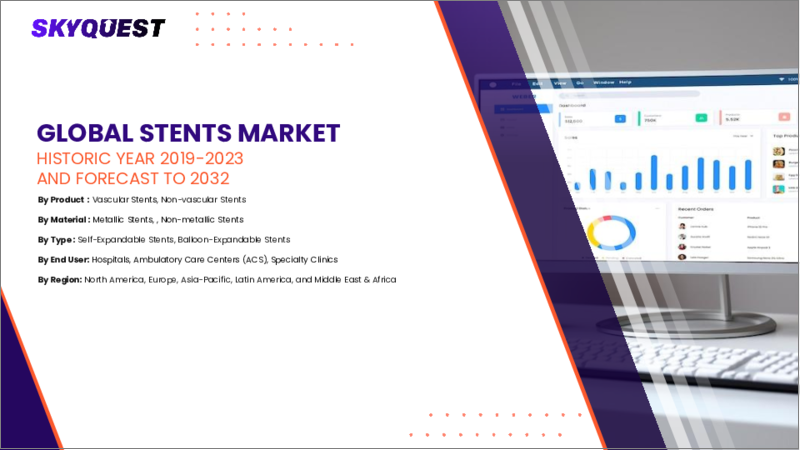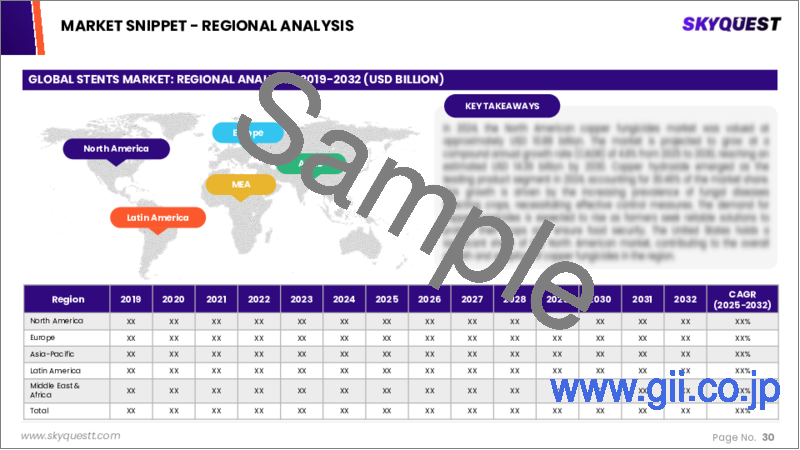|
|
市場調査レポート
商品コード
1622471
ステント市場規模、シェア、成長分析、製品別、素材別、エンドユーザー別、地域別 - 産業予測、2025~2032年Stents Market Size, Share, Growth Analysis, By Product (Vascular, Non-Vascular Stents), By Material (Metallic Stents, Non-Metallic Stents), By End User, By Region - Industry Forecast 2025-2032 |
||||||
|
|||||||
| ステント市場規模、シェア、成長分析、製品別、素材別、エンドユーザー別、地域別 - 産業予測、2025~2032年 |
|
出版日: 2024年12月23日
発行: SkyQuest
ページ情報: 英文 157 Pages
納期: 3~5営業日
|
全表示
- 概要
- 目次
ステント市場規模は2023年に93億米ドルと評価され、2024年の96億1,000万米ドルから2032年には125億米ドルに成長し、予測期間(2025年~2032年)のCAGRは3.3%で成長する見通しです。
世界のステント市場は、CDCによると2019年に約360,900人の死亡につながった冠動脈疾患の有病率の上昇に牽引され、大きな成長を目の当たりにしています。この急成長は、ステント設計の技術的進歩、ヘルスケア開発への民間および政府からの投資の高まり、薬剤溶出ステントの需要の高まりによって推進されています。閉塞した動脈の血流を維持するために不可欠な医療機器であるステントは、心血管疾患だけでなく、大動脈や脳といった重要な部位の動脈瘤の予防にも活用されるようになってきています。その顕著な例として、2021年8月にSinomedがHTスプリーム薬剤溶出ステントを欧州で発売したことが挙げられ、業界の絶え間ない革新と患者ニーズへの対応が強調されています。
目次
イントロダクション
- 調査の目的
- 調査範囲
- 定義
調査手法
- 情報調達
- 二次データと一次データの方法
- 市場規模予測
- 市場の前提条件と制限
エグゼクティブサマリー
- 世界市場の見通し
- 供給と需要の動向分析
- セグメント別機会分析
市場力学と見通し
- 市場概要
- 市場規模
- 市場力学
- 促進要因と機会
- 抑制要因と課題
- ポーターの分析
主な市場の考察
- 重要成功要因
- 競合の程度
- 主な投資機会
- 市場エコシステム
- 市場の魅力指数(2024年)
- PESTEL分析
- マクロ経済指標
- バリューチェーン分析
- 価格分析
- 技術の進歩
- 貿易分析
ステント市場規模:製品別
- 市場概要
- 血管
- 冠動脈ステント
- 周辺機器ステント
- 腸骨動脈ステント
- 大腿動脈ステント
- 頸動脈ステント
- 腎動脈ステント
- その他周辺機器ステント
- 神経血管ステント
- 頭蓋内ステント
- フローダイバータ
- 非血管系ステント
- 胃腸ステント
- 胆道
- 十二指腸
- 結腸
- 膵臓
- 食道ステント
- 肺(気道)ステント
- シリコンエアウェイ
- 金属製気道
- 泌尿器科ステント
- その他
ステント市場規模:素材別
- 市場概要
- メタリックステント
- 非金属ステント
ステント市場規模:エンドユーザー別
- 市場概要
- 病院
- 専門クリニック
- 外来手術センター
- その他
ステント市場規模
- 北米
- 米国
- カナダ
- 欧州
- ドイツ
- スペイン
- フランス
- 英国
- イタリア
- その他欧州地域
- アジア太平洋地域
- 中国
- インド
- 日本
- 韓国
- その他アジア太平洋地域
- ラテンアメリカ
- ブラジル
- その他ラテンアメリカ地域
- 中東・アフリカ
- GCC諸国
- 南アフリカ
- その他中東・アフリカ
競合情報
- 上位5社の比較
- 主要企業の市場ポジショニング(2024年)
- 主な市場企業が採用した戦略
- 市場の最近の動向
- 企業の市場シェア分析(2024年)
- 主要企業の企業プロファイル
- 会社概要
- 製品ポートフォリオ分析
- セグメント別シェア分析
- 収益の前年比比較(2022-2024)
主要企業プロファイル
- Boston Scientific
- Medtronic
- Abbott Laboratories
- Terumo Corporation
- Johnson & Johnson
- B. Braun Melsungen AG
- BIOTRONIK SE & Co. KG
- Cook Medical
- MicroPort Scientific Corporation
- Sahajanand Medical Technologies
- Alvimedica
- Biosensors International
- Lepu Medical Technology
- Meril Life Sciences
- Balton Sp. z o.o.
- Translumina Therapeutics
- Vascular Concepts
- Relisys Medical Devices
- Endocor GmbH
- Hexacath
結論と推奨事項
Stents Market size was valued at USD 9.3 Billion in 2023 and is poised to grow from USD 9.61 Billion in 2024 to USD 12.5 Billion by 2032, growing at a CAGR of 3.3% during the forecast period (2025-2032).
The global stents market is witnessing significant growth driven by the rising prevalence of coronary artery disease, which led to approximately 360,900 deaths in 2019, according to the CDC. This surge is propelled by technological advancements in stent design, heightened investment from both private and government sources into healthcare development, and an escalating demand for drug-eluting stents. Stents, essential medical devices that maintain blood flow in blocked arteries, are increasingly being utilized not only for cardiovascular diseases but also for preventing aneurysms in critical areas like the aorta and brain. A notable example includes the European launch of the HT Supreme Drug-eluting stent by Sinomed in August 2021, highlighting the industry's continuous innovation and response to patient needs.
Top-down and bottom-up approaches were used to estimate and validate the size of the Stents market and to estimate the size of various other dependent submarkets. The research methodology used to estimate the market size includes the following details: The key players in the market were identified through secondary research, and their market shares in the respective regions were determined through primary and secondary research. This entire procedure includes the study of the annual and financial reports of the top market players and extensive interviews for key insights from industry leaders such as CEOs, VPs, directors, and marketing executives. All percentage shares split, and breakdowns were determined using secondary sources and verified through Primary sources. All possible parameters that affect the markets covered in this research study have been accounted for, viewed in extensive detail, verified through primary research, and analyzed to get the final quantitative and qualitative data.
Stents Market Segmental Analysis
Global Stents Market is segmented by product, material, end user and region. Based on product, the market is segmented into vascular and non-vascular stents. Based on material, the market is segmented into metallic stents and non-metallic stents. Based on end user, the market is segmented into hospitals, specialty clinics, ambulatory surgery centers and others. Based on region, the market is segmented into North America, Europe, Asia Pacific, Latin America and Middle East & Africa.
Driver of the Stents Market
The stent market is significantly driven by the increasing global incidence of cardiovascular diseases (CVDs), which is anticipated to enhance market growth in the coming years. The rise in chronic disease cases is leading to greater demand for procedures such as percutaneous coronary interventions and peripheral vascular surgeries. The World Health Organization (WHO) reports that cardiovascular diseases result in approximately 17.9 million deaths annually, representing around 32% of all global fatalities. As the number of individuals affected by cardiovascular conditions continues to grow, it will inevitably heighten the need for stents, thereby propelling market demand.
Restraints in the Stents Market
One significant restraint on the stents market is the rigorous regulatory environment that hinders its growth potential. Various regulatory agencies, including the FDA, enforce stringent guidelines and requirements for the safe and effective use of stents. The FDA's thorough evaluation process necessitates a careful review of existing literature and pre-clinical animal studies prior to granting approval. This process is often resource-intensive, demanding considerable time and financial investment, particularly as coronary stents are classified as category III devices. Additionally, the classification of stents as medium to high-risk medical devices subjects them to stringent regulatory compliance, ultimately dampening market demand due to the complexity and costs associated with obtaining necessary approvals.
Market Trends of the Stents Market
The stents market is witnessing significant growth driven by continuous innovations and refinements in product design. Key advancements focus on optimizing stent features, such as reducing strut thickness, enhancing deliverability in complex vascular anatomies, and introducing a variety of lengths and diameters. Recent breakthroughs, like the FDA-approved Xience Sierra in 2018, emphasize enhanced flexibility and smaller profiles for improved performance during percutaneous coronary interventions (PCI). These developments aim to enhance patient outcomes and reduce procedural complications, thereby fueling market expansion. As healthcare providers increasingly adopt these advanced stent technologies, the market is poised for robust growth in the coming years.
Table of Contents
Introduction
- Objectives of the Study
- Scope of the Report
- Definitions
Research Methodology
- Information Procurement
- Secondary & Primary Data Methods
- Market Size Estimation
- Market Assumptions & Limitations
Executive Summary
- Global Market Outlook
- Supply & Demand Trend Analysis
- Segmental Opportunity Analysis
Market Dynamics & Outlook
- Market Overview
- Market Size
- Market Dynamics
- Drivers & Opportunities
- Restraints & Challenges
- Porters Analysis
- Competitive rivalry
- Threat of substitute
- Bargaining power of buyers
- Threat of new entrants
- Bargaining power of suppliers
Key Market Insights
- Key Success Factors
- Degree of Competition
- Top Investment Pockets
- Market Ecosystem
- Market Attractiveness Index, 2024
- PESTEL Analysis
- Macro-Economic Indicators
- Value Chain Analysis
- Pricing Analysis
- Technological Advancement
- Trade Analysis
Global Stents Market Size by Product & CAGR (2025-2032)
- Market Overview
- Vascular
- Coronary Stents
- Peripheral Stents
- Iliac Artery Stents
- Femoral Artery Stents
- Carotid Artery Stents
- Renal Artery Stents
- Other Peripheral Stents
- Neurovascular Stents
- Intracranial Stents
- Flow Diverters
- Non-Vascular Stents
- Gastrointestinal Stents
- Biliary
- Duodenal
- Colonic
- Pancreatic
- Esophageal Stents
- Pulmonary (Airway) Stents
- Silicone Airway
- Metallic Airway
- Urological Stents
- Others
Global Stents Market Size by Material & CAGR (2025-2032)
- Market Overview
- Metallic Stents
- Non-Metallic Stents
Global Stents Market Size by End User & CAGR (2025-2032)
- Market Overview
- Hospitals
- Specialty Clinics
- Ambulatory Surgery Centers
- Others
Global Stents Market Size & CAGR (2025-2032)
- North America (Product, Material, End User)
- US
- Canada
- Europe (Product, Material, End User)
- Germany
- Spain
- France
- UK
- Italy
- Rest of Europe
- Asia Pacific (Product, Material, End User)
- China
- India
- Japan
- South Korea
- Rest of Asia-Pacific
- Latin America (Product, Material, End User)
- Brazil
- Rest of Latin America
- Middle East & Africa (Product, Material, End User)
- GCC Countries
- South Africa
- Rest of Middle East & Africa
Competitive Intelligence
- Top 5 Player Comparison
- Market Positioning of Key Players, 2024
- Strategies Adopted by Key Market Players
- Recent Developments in the Market
- Company Market Share Analysis, 2024
- Company Profiles of All Key Players
- Company Details
- Product Portfolio Analysis
- Company's Segmental Share Analysis
- Revenue Y-O-Y Comparison (2022-2024)
Key Company Profiles
- Boston Scientific
- Company Overview
- Business Segment Overview
- Financial Updates
- Key Developments
- Medtronic
- Company Overview
- Business Segment Overview
- Financial Updates
- Key Developments
- Abbott Laboratories
- Company Overview
- Business Segment Overview
- Financial Updates
- Key Developments
- Terumo Corporation
- Company Overview
- Business Segment Overview
- Financial Updates
- Key Developments
- Johnson & Johnson
- Company Overview
- Business Segment Overview
- Financial Updates
- Key Developments
- B. Braun Melsungen AG
- Company Overview
- Business Segment Overview
- Financial Updates
- Key Developments
- BIOTRONIK SE & Co. KG
- Company Overview
- Business Segment Overview
- Financial Updates
- Key Developments
- Cook Medical
- Company Overview
- Business Segment Overview
- Financial Updates
- Key Developments
- MicroPort Scientific Corporation
- Company Overview
- Business Segment Overview
- Financial Updates
- Key Developments
- Sahajanand Medical Technologies
- Company Overview
- Business Segment Overview
- Financial Updates
- Key Developments
- Alvimedica
- Company Overview
- Business Segment Overview
- Financial Updates
- Key Developments
- Biosensors International
- Company Overview
- Business Segment Overview
- Financial Updates
- Key Developments
- Lepu Medical Technology
- Company Overview
- Business Segment Overview
- Financial Updates
- Key Developments
- Meril Life Sciences
- Company Overview
- Business Segment Overview
- Financial Updates
- Key Developments
- Balton Sp. z o.o.
- Company Overview
- Business Segment Overview
- Financial Updates
- Key Developments
- Translumina Therapeutics
- Company Overview
- Business Segment Overview
- Financial Updates
- Key Developments
- Vascular Concepts
- Company Overview
- Business Segment Overview
- Financial Updates
- Key Developments
- Relisys Medical Devices
- Company Overview
- Business Segment Overview
- Financial Updates
- Key Developments
- Endocor GmbH
- Company Overview
- Business Segment Overview
- Financial Updates
- Key Developments
- Hexacath
- Company Overview
- Business Segment Overview
- Financial Updates
- Key Developments





